
Hoar Frost Photographyby Dr. Robert Berdan
Robin feeding on Saskatoon berries covered in hoar frost - makes me wonder if the birds like Saskatoon ice-wine? Officially it's Spring time, but looking outside today you wouldn't know it - we have several inches of fresh snow and heavy hoar frost covers almost everything. Last week we had a few warms days and a fair bit of snow melted, but then a cold front moved back down from the north as it often does in Spring. The warm moist air mixes with the cold air and forms fog. I know when it's foggy out at night and cold their is a good chance of hoar frost in the morning. Hoar frost forms when the air is supersaturated, as the air cools the water vapor freezes on anything that is colder then the surrounding air. The scientific term for hoar frost formation is deposition, a process in which a gas (water vapor) transforms into a solid (desublimation). When hoar frost forms on the ground in mountain areas it can trigger avalanches. However, for nature photographers it can be a blessing and offers opportunities for interesting landscape and close-up photographs. Most of the photos in this article were taken on March 25 during a short walk near my home in Calgary.
Hoar frost on Shrub The name hoar is derived from old English meaning showing signs of old age in reference to the frost that forms on trees and branches that looks like white hair. Hoar frost is a beautiful form of ice that make just about anything it covers photogenic. Hoar frost can take on many shapes including: needles, cups, plates, fern-like and feather-like forms. To capture these beautiful ice forms a macro lens or telephoto lens with close-focusing capability is ideal. I also recommend using a tripod for the sharpest pictures. Most of the close-up pictures in this article were photographed using a Canon 300 mm F4 lens (between F4-F11) on a Canon 7D camera at ISO 400. Some of the pictures were taken with a wide angle lens (17-55 mm). As with most forms of winter photography I set my exposure compensation to +1 EV so the white crystals would appear white instead of gray. If you are shooting RAW files you could adjust the exposure afterwards in Adobe Photohop's Camera RAW.
Fine crystals of ice cover this small shrub near my home along the Bow river in Calgary, AB
Fence with hoar frost
Close-up view of fence showing the ice crystals
Hoar frost crystals on grass
Hoar Frost on blades of grass
Ice crystals on shrub
Hoar frost on shrubs and fence at sunrise along Old Banff coach road - temperature was -22 °C on this morning
Wid angle view of trees north of Calgary covered in hoar frost - remember to set your camera to +1 EV to properly expose
Plant frozen in ice has small ice crystal on its stem
Hoar frost crystals resembling pine needles
Ice crystals on plant stalk |














